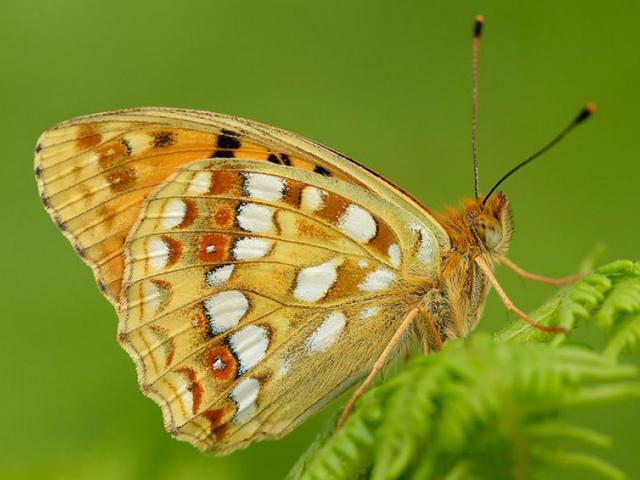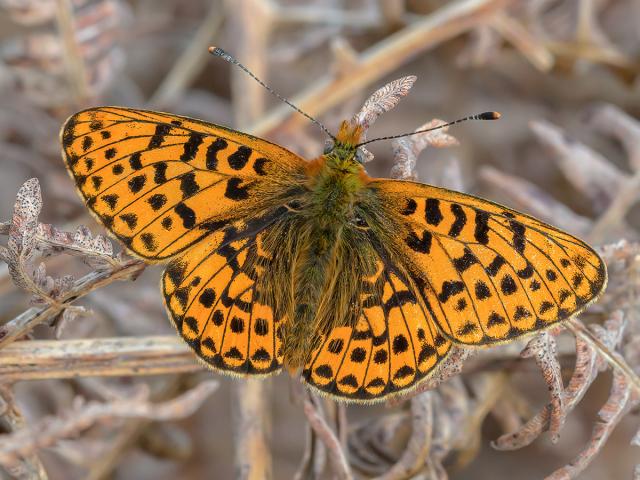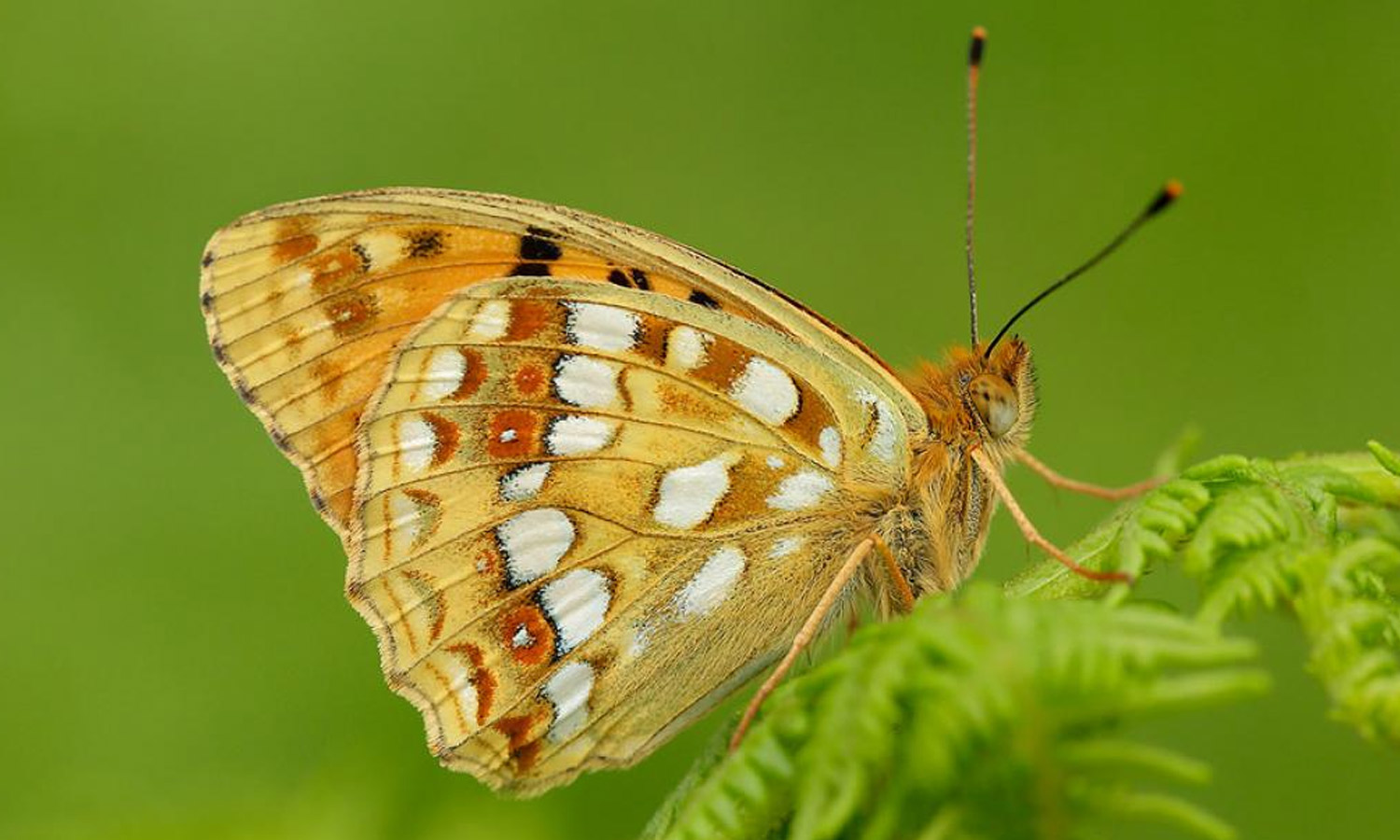Overall, 71% of butterflies in Wales have declined in abundance, distribution, or both, with those species that require specific habitats in order to thrive the worst affected.
However, despite the gloomy picture painted by the long-term trends, as is also the case elsewhere in the UK, there is evidence that targeted conservation action can turn around the fortunes of threatened butterflies at site, landscape and national levels.
Some species to highlight include:

High Brown Fritillary
Following long-term decline, High Brown Fritillary is restricted to just a single (large) site in Wales in the Alun Valley in the Vale of Glamorgan. A succession of conservation projects have taken place in this landscape since 2003, ensuring the survival of the butterfly, a Butterfly Conservation Priority Species. Through management of Bracken, scrub removal and coppicing, the area of suitable breeding habitat has been increased by two-thirds over the past 20 years. High Brown Fritillary numbers have increased in parallel, from a low of 1.5 butterflies per hour of searching in 1999 to 17.4 per hour in 2019.
Read more on the work for High Brown Fritillary in the Vale of Glamorgan.

Pearl-bordered Fritillary
Pearl-bordered Fritillary is another Priority Species that has benefitted from targeted conservation work at its few remaining Welsh sites, including Butterfly Conservation’s reserve at Eyarth Rocks, Denbighshire. Its abundance in Wales has increased by 334% (1997- 2019), helped by very good years in 2013, 2014 and 2019. However, this optimism is tempered by losses of colonies in Ceredigion and Montgomeryshire, reducing the species to only eight sites in the whole country, two of which are completely isolated from all the others. Maintenance of these remaining sites is unlikely to secure a long-term future for the butterfly in Wales and creating suitable habitat elsewhere in these landscapes is a priority.
How you can help us
You can help us to continue to halt and reverse the decline in butterflies by donating to Butterfly Conservation.
Donate to Butterfly Conservation
Cymru
At ei gilydd, mae 71% o’r glöynnod byw a geir yng Nghymru wedi dioddef dirywiad o ran helaethrwydd, dosbarthiad neu’r ddau ffactor; y rhywogaethau sydd wedi dioddef waethaf yw’r rhai sydd angen cynefinoedd penodol er mwyn gallu ffynnu.
Serch hynny, er gwaethaf y darlun tywyll a welir yn y tueddiadau hirdymor, yma a mewn lleoedd eraill ledled gwledydd Prydain, mae’na dystiolaeth i awgrymu bod gweithredu cadwraethol sydd wedi’i dargedu yn gallu gwella’r rhagolygon ar gyfer glöynnod byw sydd dan fygwth, a hynny mewn safleoedd a thirweddau penodol, a hefyd ar lefel genedlaethol.
Ymhlith y rhywogaethau sy’n haeddu sylw arbennig dylid cynnwys y rhain:
Y Fritheg Frown
A hithau wedi dioddef dirywiad dros gyfnod maith, ni welir y Fritheg Frown bellach ond mewn un safle (mawr) yng Nghymru, sef Cwm Alun ym Mro Morgannwg. Mae cyfres o brosiectau cadwraethol wedi cael eu cynnal ar y dirwedd yma ers 2003, gan sicrhau goroesiad y Fritheg Frown, sy’n un o Rywogaethau Blaenoriaethol Gwarchod Glöynnod Byw. Diolch i bolisi o reoli’r Rhedyn, dileu prysgwydd a choedlannu, mae maint y cynefin bridio addas wedi cynyddu o ddwy draean dros yr 20 mlynedd diwethaf. Mae niferoedd y Fritheg Frown wedi cynyddu’n gyfochrog, o lefel isaf o 1.5 glöyn byw yn ystod pob awr o chwilio yn 1999 i 17.4 bob awr yn 2019.
Darllenwch ragor am y gwaith a wneir dros Y Fritheg Frown ym Mro Morgannwg
Y Fritheg Berlog
Mae’r Fritheg Berlog yn Rhywogaeth Flaenoriaethol arall sydd ar ei hennill o ganlyniad i waith cadwraethol wedi’i dargedu ar yr ychydig o safleoedd lle’r deuir o hyd iddi yng Nghymru, gan gynnwys Gwarchodfa Gwarchod Glöynnod Byw yng Ngherrig Eyarth, Sir Ddinbych. Mae ei helaethrwydd wedi cynyddu o 334% (1997- 2019), a hyrwyddwyd y broses gan flynyddoedd arbennig o dda yn 2013, 2014 a 2019. Ond tanseilir unrhyw optimistiaeth yn ei chylch gan golled nythfeydd yng Ngheredigion a Sir Drefaldwyn, gan gyfyngu’r rhywogaeth i gwta wyth safle bellach yn y wlad, y mae dau ohonynt wedi’u hynysu’n llwyr o’r lleill. Mae’n annhebyg y bydd gwaith i gynnal y safleoedd sydd ar ôl yn llwyddo i sicrhau dyfodol hirdymor iddi yng Nghymru; y flaenoriaeth felly yw creu cynefin addas iddi mewn mannau eraill yn y tirweddau hyn.
Gallwch chi ein helpu ni i barhau i roi terfyn ar ddirywiad ein glöynnod byw a’i wrthdroi trwy gyfrannu arian heddiw.


